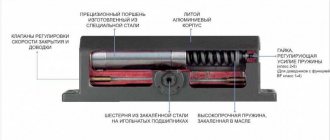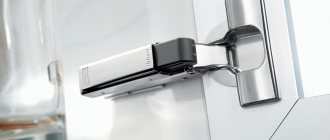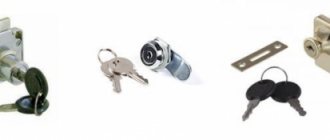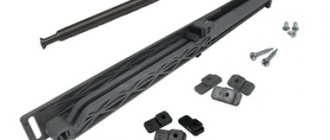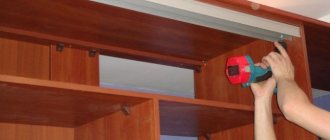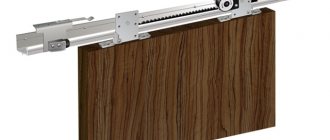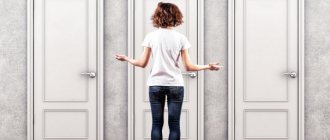Many citizens are familiar with door closers. Such mechanisms are installed on almost any entrance doors: in the entrances of residential buildings, warehouses, administrative buildings, shopping centers, etc. But immediately after installation and during operation, the devices require additional configuration. Therefore, many are interested in how to independently, without the involvement of a specialist, adjust the door closer installed in the entrance.
The concept of a closer
A door closer is a special device that is installed on entrance doors in public buildings to control their opening/closing. The mechanism allows the doors to close independently after they are opened by a person: it slowly and tightly pulls the door leaf to the frame.
The operation of the device is configured individually in each case. This depends on its location, intensity of use and physical activity.
For example, on door closers at the entrances of residential buildings and exits from supermarkets, a certain period of delay of the door leaf in the open position is configured. This is necessary so that a person can calmly leave or enter the building with his hands full.
In other public places with heavy traffic of people, such entrance door devices increase the force that must be applied to open the door leaf. This allows you to prevent premature failure of the door opening mechanism, since many users apply significant force when opening doors, especially when they are in a hurry.
Therefore, before you repair and independently configure the door closer in your entrance, it is recommended to take into account all possible nuances during the operation of the door structure.
Troubleshooting
Repairing a door closer with your own hands is not difficult.
If rod defects occur, carry out the following actions:
- If there is rust, anti-corrosion cleaning is done and treated with a special protective lubricant.
- If a small crack or break occurs, the welding method is used, after which the welds are ground to a smooth state without slag inclusions, sagging, or formations.
- Distortions or bends are carefully leveled using a hammer so that the lever does not burst under the influence of force.
If the door speed is abnormal, the device is adjusted.
How to repair
To repair breakdowns in the closer device, the following tools are required:
- screwdriver;
- keys;
- pliers;
- screwdriver.
If complex defects are identified, a hammer or welding machine is required to correct them.
The procedure for carrying out repair work is as follows:
- Carefully inspect the closer body. There should be no leakage in a housing filled with oil.
- Check the security of the mounting screws. If the part is tight or loose, tighten it to the required level.
- Inspect the door block, the place of fastening and contact with the frame for cracks and dents that lead to distortion of the structure.
- Check the operation of the closer levers.
- Adjust the speed of closing and opening doors, slam, maximum swing angle.
- If damage is detected, repair the part.
- After the procedure, install the closer in place.
If the defect cannot be corrected independently, this situation can be resolved by replacing the closer.
Types of products
Devices for automatic closing of entrance doors are divided into several types depending on the installation location.
Upper
This is a classic version of door closers, which is mounted on top of the door structure. One element of the product is attached to the door leaf, the second to the door frame.
Floor
Closers of this type are used in public places with high traffic, for example, in shopping and entertainment centers. The design of floor mechanisms uses a sliding rod. They are quite compact in size, attached to the floor covering, and are practically invisible.
Hidden
There are situations when the closing device needs to be hidden. Such mechanisms are made of two types: with a sliding rod or a combined loop-closer. The first option is installed on top of wooden door frames. In the second case, the device is hidden in a metal door hinge.
This product is considered the most inconspicuous opening mechanism for a door structure. However, such devices have serious limitations. They cannot withstand significant loads and are not durable. To extend the service life of such a device, it is necessary to reduce the pressure on it. Therefore, it is not recommended to use it for door leaves made of heavy materials.
Personal experience from scratch
In the spring of 2022, I decided to take a new direction in my entrepreneurial activity - repairing door closers
.
Initial monitoring of the issue revealed a complete lack of commercial offer for this type of service. It turned out that there were tons of offers to buy a door closer, but there was no one to order repairs. By chance or naturally?
Inspired by this observation, on the same day I added a new page to my website offering such an exclusive renovation and, without delaying the matter, set to work.
Fortunately, there was something to practice on - from the main work there were as many as five different models, “snotting” oil.
After a quick inspection of all the mechanisms, the repair seemed like a piece of cake. Everything was extremely obvious: unscrew one side bushing nut (1), change the erased oil, remove the ring (2), tighten it.
We repeat the procedure on the other side of the closer, add oil, pump it, make sure the system is tight, install it on the door, receive payment for a job well done, and leave with our heads held high.
A true gold mine of the early Klondike.
At that moment I didn’t even have a thought about the fact that I was so recklessly entering into a tedious fight with the door mafia.
- Our people are not looking for easy ways
- /Without towers, but rods like tanks/
It’s no secret that any product manufacturer creates entire design bureaus to deal with premature aging and wear of the product right before the end of the warranty. They also pay great attention to the “inability to repair in principle” of their products. Plus, there is aggressive marketing promoting always buying new rather than repairing old.
Design options
According to the type of working mechanism, cam and gear devices are distinguished. The first ones are designed for installation on lightweight door structures. They provide easy and smooth door opening.
The design of the gear mechanism of the entrance door closer differs from the cam version in the presence of a spring and a gear system. The spring is compressed as a result of strong pressure on it when the door is opened. And when a person releases the door leaf, the spring opens on its own, the closing mechanism is activated, and the leaf is pulled tightly to the door frame.
Based on the type of drive, closers are divided into electric, hydraulic and thermal drives. The entire mechanism can be housed in a plastic or steel case. Also, different models of door closers are characterized by the power of opening/closing the door leaf.
Causes of breakdowns
Types of designs
In order to eliminate a breakdown for a long time, it is necessary to determine in advance the cause of the defect.
The most common causes of problems with door closers are:
- Adverse weather conditions. These are rains, constant dampness, temperature changes, which most of all concerns plastic boxes and open metal elements;
- Sudden movement of the door leaf . If the instructions for opening or closing it are not followed, this is done faster than the adjustment of the closer suggests, and a breakdown of the mechanism will inevitably occur.
- Blocking door movement . This situation often occurs in systems where the door opening delay is not expected to be greater than 90º. If you place a stone under such a door, it will not close, and this will have a negative effect on the mechanism.
- Closer overload. This can happen when choosing a device with insufficient power for heavy doors. Overload can occur if you hang on the door or ride on it, which children especially like to do.
Installation methods
Before setting up the door closer at the entrance, it must be securely fastened. There are two options for installing such devices: classic and parallel.
In the first case, the main mechanism of the device and the rods are fixed to the door frame and the leaf from above. To do this, holes are made in the required places for the template, then the mechanism is fixed using self-tapping screws. In the second case, the parallel lever is fixed using a special metal angle.
Depending on the door design and the placement of the hinges, two automatic closing mechanisms can be installed at the same time if one is not enough to perform these functions. But it is recommended to purchase one more powerful closer.
What to do if nothing works out?
There are several reasons why the setup may not produce results:
- An inappropriate mechanism has been selected, the door is too heavy, and heavy objects are frequently hung on the door leaf.
- Incorrect fastening of the iron angle, misalignment of parts.
- Displacement of the holes for the screws on which the device is attached, unscrewing.
If one of the above points applies, then there are only two options - change the door, install a different closer. There is a third option - try to fix it yourself, but lack of experience can lead to worsening.
The lever must be positioned strictly perpendicular to the canvas, otherwise one of the parts must be moved.
The need to regulate the mechanism
After installing the closer on the door structure, it is pre-configured for standard functions. Further, during operation, it is necessary to check the operation of the mechanism monthly and, if necessary, adjust it.
Adjustment after installation
Before you independently adjust the door closer installed on the entrance door frame, you need to study its design and operating principle.
Recommendations for setting up the closer immediately after its installation:
- First of all, the decorative cover is removed from the mechanism, which, depending on its design, can be located on the side or on the front side;
- Under this cover there are mechanism adjustment bolts. Depending on the model, there can be from 2 to 5 pieces. The device is supplied with a manufacturer's instruction manual, which describes in detail which adjusting bolt is responsible for which option;
- Having understood the instructions, in order to adjust the operation of the closer, you need to alternately turn the screws to the right/left. Depending on the type of bolts, you may need a screwdriver or a special hex key.
It is not recommended to turn the adjusting screws a full turn at once. In modern devices, it is enough to turn them half a turn to feel a significant difference. It is also prohibited to adjust the closer elements while holding the door leaf.
Adjustment during operation
Setting up the automatic closing mechanism of the door leaf is carried out not only after its direct installation, but also periodically during operation. Any moving structural element fails after a certain period. Therefore, many are interested in how to independently adjust the door closer installed in the entrance of an apartment building without the involvement of a specialist.
In winter, it is recommended to adjust the closer weekly. Particular attention must be paid to elements located outdoors and in rooms with sudden temperature changes and constant changes in humidity. The moving elbow (the area connecting the lever and the main element of the closer) must be periodically cleaned of dirt and treated with machine lubricant.
Door leaf movement speed
The speed of closing the door leaf is one of the main options, which requires the adjustment of an automatic closer installed on street doors in the entrance.
Standard models of closing mechanisms are equipped with two adjusting bolts, one of which is responsible for the speed. The purpose of the screws is described in detail in the operating instructions from the manufacturer. But if it is lost, you can find the necessary screw yourself. To do this, you need to change the position of each screw by half a turn. The contact of the door leaf to the frame should occur silently.
Adjustment of aftershock
This option determines whether the door leaf will slam against the door frame during operation. The optimal door stopping angle is considered to be 15 degrees.
Features of some models
The most common door closers among users are “Dorma” TS-68, “Diplomat”, “GEZE” TS 4000. Each model has its own characteristics of regulating such devices.
"Dorma" TS-68 is a classic top-mounted model. Its peculiarity is that the mechanism is equipped with a special lever to change the door locking force.
The Diplomat model is characterized by simple installation and maintenance of the mechanism. Adjusting the door closer includes the stages of spring tension and opening and closing adjustments. Some modifications of the “Diplomat” do not have a clap setting. The devices operate on the principle of hydromechanics.
"GEZE" TS 4000 is a popular top door mechanism model among users. The closer can adjust the opening damping, adjust the thermostable closing speed at the front and the final closing using a lever rod.
